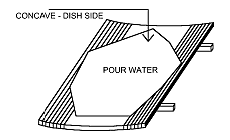DGI – REPAIR GUIDE
Cupping
“GLULAM”, being a very wide solid piece of timber, can cup when it is in an unsealed and/or unbalanced state. Cupping is natural and occurs when there is an absorption or loss of atmospheric moisture on one side of the board and not the other, causing a moisture content imbalance. This imbalance is a temporary situation and is caused when there are changes in humidity or atmospheric conditions. Proper sealing prevents an imbalance occurring.
Cupping can be corrected by reversing the cause; ie. turn the board over and just leave it, or strip the boards out so air can circulate evenly. If time doesn’t allow this, then the correction process can be hurried by wetting the dry side. This creates artificially high humidity and the dry side will absorb moisture until both sides are in equilibrium and the board is again straight.
The drier side is always the concave side. Place the board with the concave (dish) side up and on gluts so air can circulate (This also helps to dry out the wet side). Pour water on to the top (into the dish) until it pools evenly across the whole board. Lay plastic over the top so the water doesn’t evaporate too quickly and leave it. The bigger the cup, the longer it will take to correct, but check it after an hour or two for progress. After the correction is completed, the water will have raised the wood fibres so it may be necessary to lightly sand again. Seal the board as soon as possible.

Endsplits
If “GLULAM” is left unsealed, it is possible for the board to loose excess moisture via the end grain particularly when the temperature exceeds 25°C. This moisture loss can cause minor openings of the gluelines at the ends of the board. This is a common occurrence and is no indication of glue failure or delamination.
To obviate the problem before it occurs, ensure that the ends of the board are well sealed. To repair minor endsplits fill with clear silicon (eg. Silastic) and seal: the splits should then close naturally. If the end splits are longer, let some full strength Epoxy glue flow into the split/s, clamp and allow to cure before sealing. A strip of tape underneath the glueline stops glue loss.
Minor Dents
A small dent can be easily fixed by recovering the crushed wood cells with an application of steam. To achieve this place a very damp rag over the dent and sit a hot iron on the damp rag. Allow the wet heat to penetrate the timber. The time for it to recover will vary according to the severity of the dent and the density of the timber. Check on progress after a minute or two and if necessary repeat. Finish with a light sand particularly if the wood fibres have been broken or damaged. This process can also be done over a finish but takes longer.
Natural Timber Blemishes
Any grain checking, tearout and similar timber blemishes can be filled with a matching wood putty and then sanded smooth. Shakes and similar blemishes which have a tendency to lift can be glued down using a five minute Epoxy glue mixed with matching colour sanding dust.
Alternatively, to make a blemish appear natural, apply “Plastibond” coloured with a very small amount of oxide of suitable colour. Sand smooth when it has set. If filling as above is impractical because of aesthetics, a portion of the laminate (approx 3mm deep) can be removed with a router and replaced with a fillet (a strip of similar timber ripped to the matching width and thickness) glued in place with a full strength Epoxy glue, and then sanded.
Remove Stains
Sanding will remove most stains, however in some timbers, tannin stains and water stains are stubborn. Soak the surface to be cleaned with clean water, mix Oxalic Acid with water as per the instructions on the pack, then brush the solution on and allow it to react for about two hours. Wash down the surface and allow it to dry. If the stain is still visible then repeat the process. When stain free, fine sand.
Splits & Shakes
Minor shakes and splits in wide slabs of timber are rare, but normal. They are usually caused by contraction of the top after installation as the benchtop ‘normalises’ to the humidity of the site environment. They can be easily repaired at any time using the following method.
STEP 1: Using a fine blade (scalpel or craft knife is ideal), clean out the split. Remove any gum residue or flaking timber/finish.
STEP 2: Put some Plastibond Part A onto a piece of scrap. DO NOT ADD HARDENER YET.
STEP 3: Add a little of the yellow oxide powder as a base. With the light coloured timbers (Oak/Ash/Elm/Maple) this could be adequate. Try a little of the colour on a piece of the timber and then wipe off. If needed on the darker/redder timbers or to match, add a very little of the brown or red as required. The brown & red are very strong colours, and only a few grains are needed to make a significant difference. If too dark after adding colours, add more yellow to lighten. If running into problems, discard first mix and start again.
STEP 4: When colour is right, add Part B (hardener) at ratio of 10 parts A to 1 part B. Mix up well.
STEP 5: Fill hole, leaving slightly proud, but not too much as you will later have to remove any excess.
STEP 6: Wait for Plastibond to cure. Shouldn’t take more than 5 minutes; Put a match in the leftover on the scrap, and when the match is stuck it has gone off.
STEP 7: Using a “Bigger Boy” type steel-wool pad, moistened with some “Wattyl” Teak Oil (also called ‘Scandinavian Finishing Oil’), remove excess by rubbing with grain.
You may leave a slight dull patch where you have been rubbing. This is normal and if left, will polish up naturally with normal wiping down of benchtop in use. A little “O’Cedar” polish wiped over the patch helps though, and is compatible with the polyurethane in the Teak Oil.
YOU WILL NEED:
Scalpel, Coloured Oxides, Plastibond (National Starch), Teak Oil (Wattyl) Steel Wool (Bigger Boy), “O’Cedar” (Prestige).
